The AMD 2nd Gen Ryzen Deep Dive: The 2700X, 2700, 2600X, and 2600 Tested
by Ian Cutress on April 19, 2018 9:00 AM ESTPrecision Boost 2 and XFR2: Ensuring It Hertz More
One of the biggest changes for the new Ryzen-2000 series is in how the processor implements its turbo. Up until this point (except the recent APU launch), processors have relied on a step function implementation: the system determines how many threads are loaded, attempts to implement a specific frequency on those cores if possible, and then follows the look-up table relating thread count to frequency. AMD’s goal in Precision Boost 2 is to make this process more dynamic.
This image from AMD is how the feature is being represented: the system will determine how much of the power budget is still available, and turbo as much as possible until it hits one of the limiting factors. These factors can be any of, but not limited to, the following:
- Total chip peak power
- Individual core voltage/frequency response
- Thermal interactions between neighboring cores
- Power delivery limitations to individual cores/groups of cores
- Overall thermal performance
AMD’s new Ryzen Master 1.3 software, when used on a Ryzen 2000-series processor, has several indicators to determine what the limiting factors are. For the most part, the way the processor will boost and respond to the environment, will be transparent to the user.
The best way to test this in action, from my perspective, is to look at the power draw of the first generation and second generation Ryzen processors. We can examine the internal estimated power consumption of each core individually as thankfully AMD has left these registers exposed, to give the following data:
This is only the core consumption power, not the package power, which would include the DRAM controller, the Infinity Fabric, and the processor IO. This means we get numbers different to the rated TDP, but the danger here is that because the Ryzen 7 2700X has a 10W TDP higher than the Ryzen 7 1800X, where the 2700X draws more power it could seem as if that is the TDP response.
Just plotting the power consumption gives this graph:
Even in this case it is clear that the Ryzen 7 2700X is drawing more power, up to 20W more, for a variable threaded load. If we change the graph to be a function of peak power:
The results are not quite as clear: it would seem that the 1800X draws, as a percentage of peak power, more at low thread count, but the 2700X draws more at a middling thread count.
It is worth noting that the end result of Precision Boost 2 is two-fold: more performance, but also more power consumption. Users looking to place one of the lower powered processors into a small form factor system might look at disabling this feature and returning to a standard step-function response in order to keep the thermal capabilities in check.
A side note – despite the marketing name being called ‘Precision Boost 2’, the internal BIOS name is called ‘Core Performance Boost’. It sounds similar to Multi-Core Enhancement, which is a feature on some Intel motherboards designed to go above and beyond the turbo mechanism. However, this is just AMD’s standard PB2: disabling it will disable PB2. Initially we turned it off, thinking it was a motherboard manufacturer tool, only to throw away some testing because there is this odd disconnect between AMD’s engineers and AMD’s marketing.
Extended Frequency Range 2 (XFR2)
For the Ryzen 2000-series, AMD has changed what XFR does. In the previous generation it was applied on certain processors to allow them to boost above the maximum turbo frequency when the thermal situation was conducive to higher frequencies and higher voltage in low thread-count states. For this generation, it still relates to thermals, however the definition is applied to any core loading: if the CPU is under 60ºC, the processor can boost no matter what the loading is above its Precision Boost 2 frequency (so why not get a better PB2 implementation?). The core still has to be within a suitable voltage/frequency window to retain stability, however.
On certain motherboards, like the ASUS Crosshair VII Hero, there are additional options to assist XFR2 beyond AMD’s implementation. ASUS does not go into specific details, however I suspect it implements a more aggressive version, perhaps extending the voltage/frequency curve, raising the power limits, and/or adjusting the thermal limit.


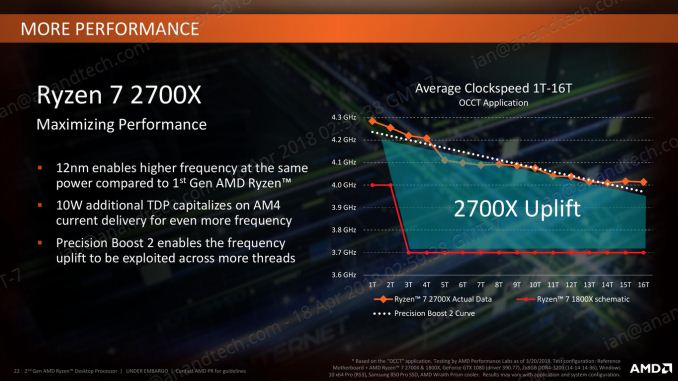
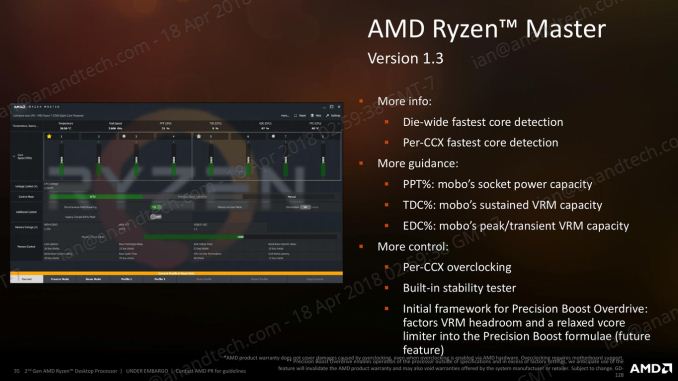

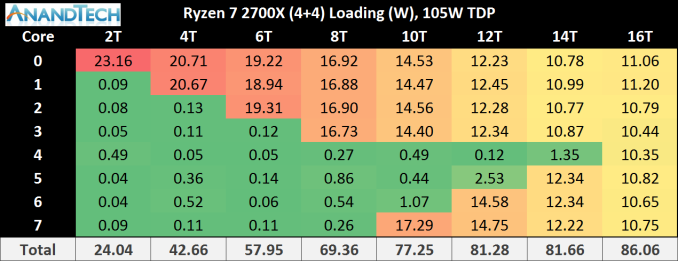
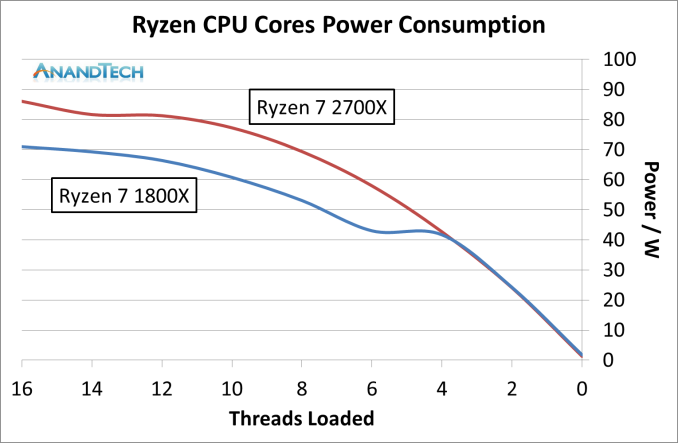
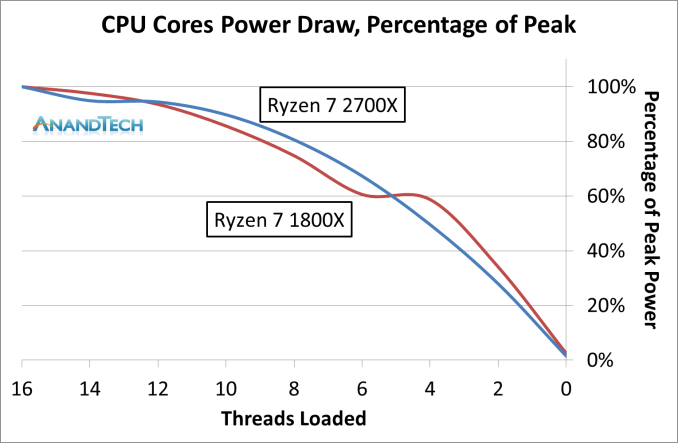
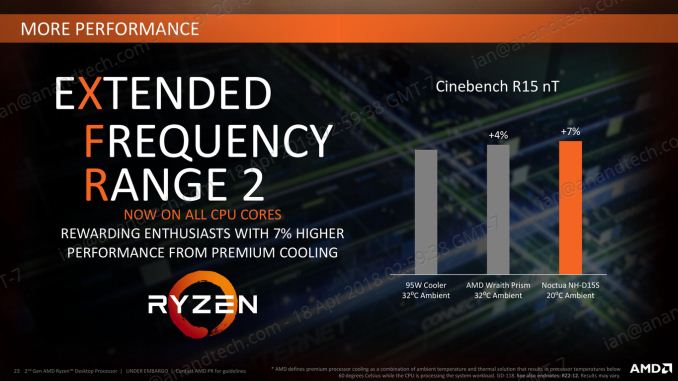








545 Comments
View All Comments
MDD1963 - Friday, April 20, 2018 - link
The Gskill 32 GB kit (2 x 16 GB/3200 MHz) I bought 13 months ago for $205 is now $400-ish...andychow - Friday, April 20, 2018 - link
Ridiculous comment. 7 years ago I bought 4x8 GB of RAM for $110. That same kit, from the same company, seven years later, now sells for $300. 4x16GB kits are around $800. Memory prices aren't at all the way they've always been. There is clear collusion going on. Micron and SK Hynix have both seen their stock price increase 400% in the last two years. 400%!!!!!The price of RAM just keeps increasing and increasing, and the 3 manufacturers are in no hurry to increase supply. They are even responsible for the lack of GPUs, because they are the bottleneck.
spdragoo - Friday, April 20, 2018 - link
You mean a price history like this?https://camelcamelcamel.com/Corsair-Vengeance-4x8G...
Or perhaps, as mentioned here (https://www.techpowerup.com/forums/threads/what-ha... how the previous-generation RAM tends to go up in price once the manufacturers switch to the next-gen?
Since I KNOW you're not going to claim that you bought DDR4 RAM 7 YEARS AGO (when it barely came out 4 years ago)...
Alexvrb - Friday, April 20, 2018 - link
I love how you ignored everyone that already smushed your talking points to focus on a post which was likely just poorly worded.RAM prices have traditionally gone DOWN over time for the same capacity, as density improves. But recently the limited supply has completely blown up the normal price-per-capacity-over-time curve. Profit margins are massive. Saying this is "the same as always" is beyond comprehension. If it wasn't for your reply I would have sworn you were simply trolling.
Anyway this is what a lack of genuine competition looks like. NAND market isn't nearly as bad but there's supply problems there too.
vext - Friday, April 20, 2018 - link
True. When prices double with no explanation, there must be collusion.The same thing has happened with videocards. I have great doubts about bitcoin mining as a driver for those price increases. If mining was so profitable, you would think there would be a mad scramble to design cards specifically for mining. Instead the load falls on the DYI consumer.
Something very odd is happening.
Alexvrb - Friday, April 20, 2018 - link
They DO design things specifically for mining. It's called an ASIC miner. Unfortunately for us, some currencies are ASIC-resistant, and in some cases they can potentially change the algorithm, which makes such (expensive!) development challenging.Samus - Friday, April 20, 2018 - link
Yep. I went with 16GB in 2013-2014 just because I was like meh what difference does $50-$60 make when building a $1000+ PC. These days I do a double take when choosing between 8GB and 16GB for PC's I build. Even hardcore gaming PC's don't *NEED* more than 8GB, so it's worth saving $100+Memory prices have nearly doubled in the last 5 years. Sure there is cheap ram, there always has been. But a kit of quality Gskill costs twice as much as a comparable kit of quality Gskill cost in 2012.
FireSnake - Thursday, April 19, 2018 - link
Awesome, as always. Happy reading! :)Chris113q - Thursday, April 19, 2018 - link
Your gaming benchmarks results are garbage and every other reviewer got different results than you did. I hope no one takes this review seriously as the data is simply incorrect and misleading.Ian Cutress - Thursday, April 19, 2018 - link
Always glad to see you offer links to show the differences.We ran our tests on a fresh version of RS3 + April Security Updates + Meltdown/Spectre patches using our standard testing implementation.